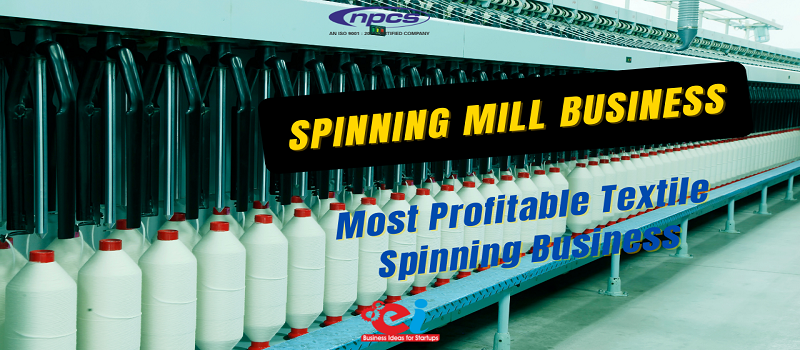A spinning mill is a textile production facility that turns raw materials like cotton, wool, linen and silk into threads used in weaving textiles. Most spinning mills purchase their cotton from wholesalers and use it to produce yarn for sale. Other spinning mills spin their own raw materials on-site to create fabrics or textile products. A company may have one or more spinning mills that serve as its primary means of fabric production. In addition, large manufacturers may also contract out some of their thread production to smaller spinning mills.
Visit this Page for More Information: Start a Business in Textile Processing Industry
The Start-Up Procedure for a Spinning Mill
A Step-by-Step Guide: Starting a spinning mill from the ground up, no matter how lucrative it may appear, is not easy. If you wish to establish a spinning mill, you must first learn everything there is to know about it. Here’s how: First and foremost, establish your business site — obtaining land and developing space with the necessary infrastructure will take a considerable investment. Then build your entire plan around it. Product selection — what kind of product do you want to make? What is the price range? Who are you going to target as your customers? This list may go on and on, but one thing you must do first is create clear goals for yourself.
Read Similar Articles: Textile Industry
Start small – Don’t be intimidated by large numbers or ambitious ambitions at first; start small and gradually increase your success. Feel free to extend your operations once you’ve established a solid basis for your company. Maintain employee satisfaction — Startups sometimes fail due to a lack of finance, poor management, or poor planning. You don’t want your business to suffer as a result of any of these factors, so pay close attention to aspects like employee satisfaction and overall company culture at all stages of development.
Related Project Report: Rising Demand in Spinning Mill
Always have a contingency plan in place — in business, unexpected events are going to occur, which is why you should always be prepared for them. The greatest way to deal with obstacles is to meet them straight on rather than attempting to avoid them altogether. Be adaptable, robust, and flexible, and keep developing until you find a solution that works for your company.
Read our Books Here: Textile Spinning, Processing, Natural Fibers, Natural Dyes, Pigments, Textile Dyes, Pigments, Dye Intermediates, Woollen Spinning, Weaving, Knitting, Dyeing Technology
Starting a Spinning Mill Has Its Benefits
Owning your own mill provides you with several tax benefits that are not available to people who don’t own and operate their own business. For example, most types of income generated by a spinning mill are considered pass-through income, which means they do not get taxed twice—once at the corporate level and again when they reach your hands. In addition, you can use various tax deductions to offset any taxable profits you make from selling textiles, yarns and rovings.
Related Feasibility Study Reports: TEXTILE BLEACHING, DYEING, SPINNING, WEAVING, PRINTING, FINISHING AND TEXTILE AUXILIARIES PROJECTS
Depending on how your business is structured, these deductions could include depreciation for property used in production; clothing purchases for employees; and travel expenses related to sales. Income made from selling textiles or yarns is also exempt from Social Security taxes if certain requirements are met. And if you hire employees to work in your textile processing operation, you will be able to claim exemptions for hiring veterans and disabled workers through Work Opportunity Tax Credits (WOTC).
Market Outlook
The worldwide textile industry was valued at USD 1000.3 billion in 2020, and between 2021 and 2028, it is predicted to increase at a CAGR of 4.4 percent.
Over the forecast period, the market is predicted to be driven by rising demand for garments from the fashion industry, as well as the rise of e-commerce platforms. The textile industry is based on three main principles: designing, producing, and distributing flexible materials like yarn and clothes. Knitting, crocheting, weaving, and other methods are commonly employed to make a wide range of completed and semi-finished goods in the bedding, apparel, garment, medicinal, and other accessory sectors.
Watch other Informative Videos: Textile Industry
The textile industry is at the top of the food chain in India’s manufacturing industry. It was expected to contribute 14% to industrial output, 4% to GDP, and around 11% to India’s export revenues. In addition, it directly employs over 35 million people, making it the country’s second largest employer. It has direct linkages to the rural economy, which is based on fibre crops, as well as a range of crafts, including as those involving cotton, wood, and silk, and handlooms, which employ millions of farmers and craftsmen in rural and semi-urban areas. In a global context, the industry accounts for 61% of loomage, 22% of spindleage, 12% of textile fibres and yarn output, and 25% of total world cotton yarn production.
See More Links:
Start a Business in Potential Countries for Doing Business
Best Industry for Doing Business
Business Ideas with Low, Medium & High Investment
Looking for Most Demandable Business Ideas for Startups

